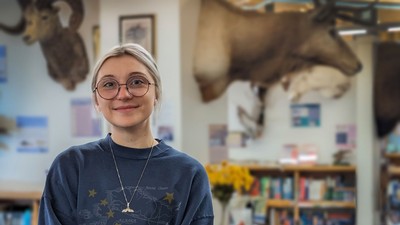Celebrating Pride: USU Researcher Asks What Makes LGBTQIA+ Birders Feel Welcome
By Lael Gilbert |
Georgie Corkery studies how queer birders perceive diversity statements from birding organizations and to what degree they facilitate a sense of belonging, comfort and safety while participating in birding.
To celebrate Pride Month in June, a Utah State Today series is highlighting university employees and students who are conducting research, academic pursuits and other projects related to or that benefit the LGBTQIA+ community.
Georgie Corkery
Master's Student in Environment and Society, Quinney College of Natural Resources
Area of work:
Diversity efforts within the birding community
Why is this work important?
National and local birding organizations often include diversity language as part of mission statements — but not much is known about how the queer community perceives these efforts and what benefits they offer. This research uses a queer ecology framework to examine and offer suggestions for improvement to organizational inclusion efforts.
Summary of research:
Statements about diversity, equality and inclusion (DEI) offered by local and national birding organizations vary from just a few sentences to a 45-page document; but there is little information on whether these statements work, how queer birders perceive them, and to what degree they facilitate a sense of belonging, comfort and safety while birding. Georgie Corkery uses a queer ecology lens to evaluate the issue.
Queer ecology is a perspective that views nature, biology, and sexuality beyond dualistic thinking. Traditionally people have relied on terms like "natural and unnatural" to describe ecological systems — but in reality, nature exists along a continuum. Paradigms from queer ecology that move beyond dualism can have a lot of impact for the queer community, according to Corkery, and can be socially and emotionally empowering, as well as benefiting the scientific community.
Take, for instance, a pair of male griffon vultures at the Artis zoo in Amsterdam that, after years of building nests together, successfully nurtured a hatchling after taking on an abandoned egg in the aviary unit, she said. It’s common for same-sex couples to form in the animal kingdom, but it’s not often recognized because of the prevalent binary thinking.
“Birding and birds are super queer. When you see a certain bird species, you don’t call it ‘male,’ you say it is ‘male by plumage.’ You really can’t make assumptions until you gather more information,” Corkery said. “It parallels how queer community members may feel and breaks from the gender binary default thinking historically ascribed to biology and ecology.”
Birding as an outdoor activity does not have diverse participation, Corkery said. Her research is an effort to change that, not just to make the activity more inclusive and equitable but to boost an aging cohort of birders. Her main goal is to connect communities that might experience hidden barriers to participating, and to inspire a sense of wonder and stewardship for birds and the natural environment.
Corkery is working to produce a DEI handbook template for the birding community, with feedback from queer collaborators and other groups, to offer information about how these organizations can make on-the-ground progress toward their DEI goals. She intends it to be a living document that evolves as groups gain a more nuanced perspective of the issues.
WRITER
Lael Gilbert
Public Relations Specialist
Quinney College of Natural Resources
435-797-8455
lael.gilbert@usu.edu
TOPICS
Outdoor 78stories LGBTQIA+ 45storiesComments and questions regarding this article may be directed to the contact person listed on this page.







